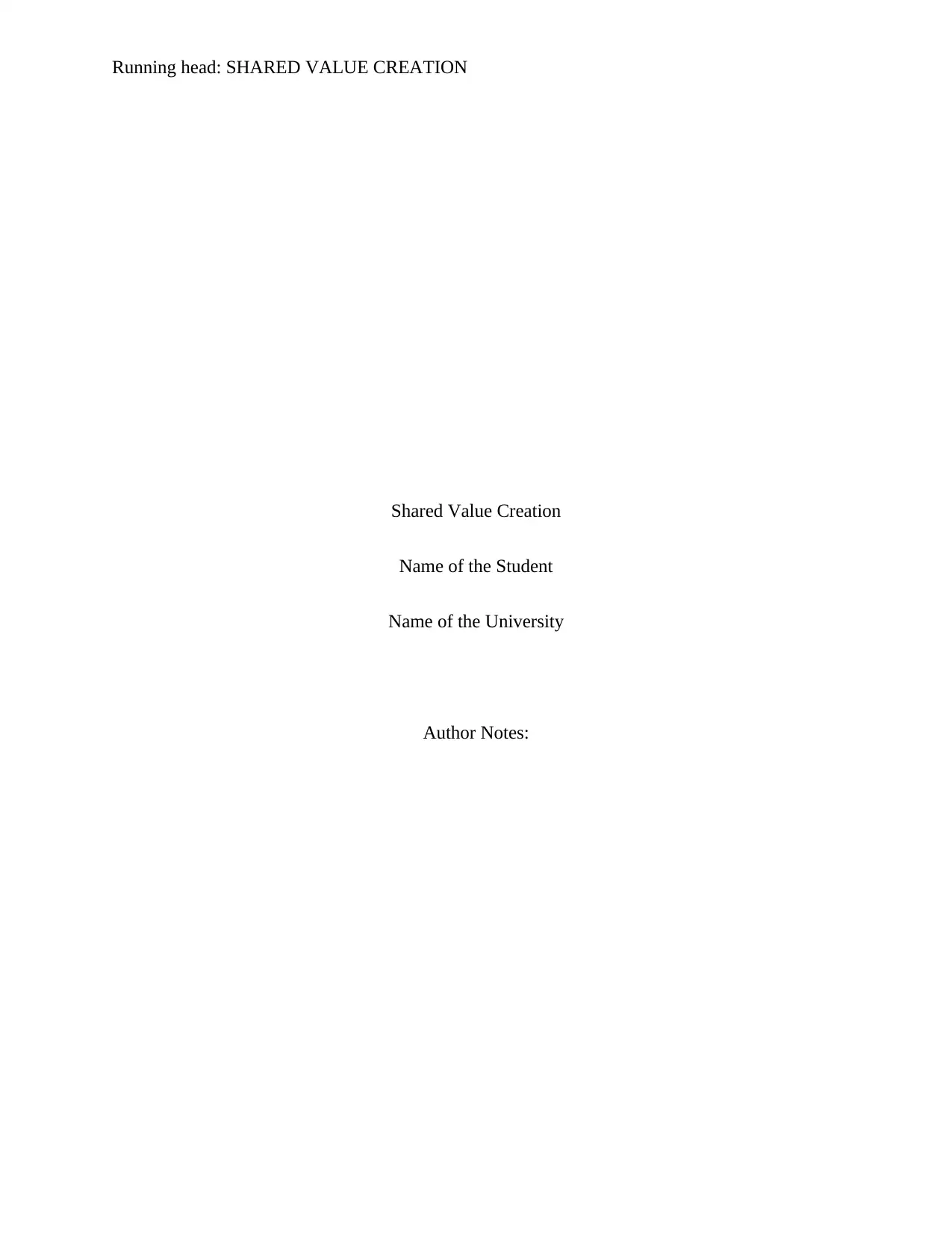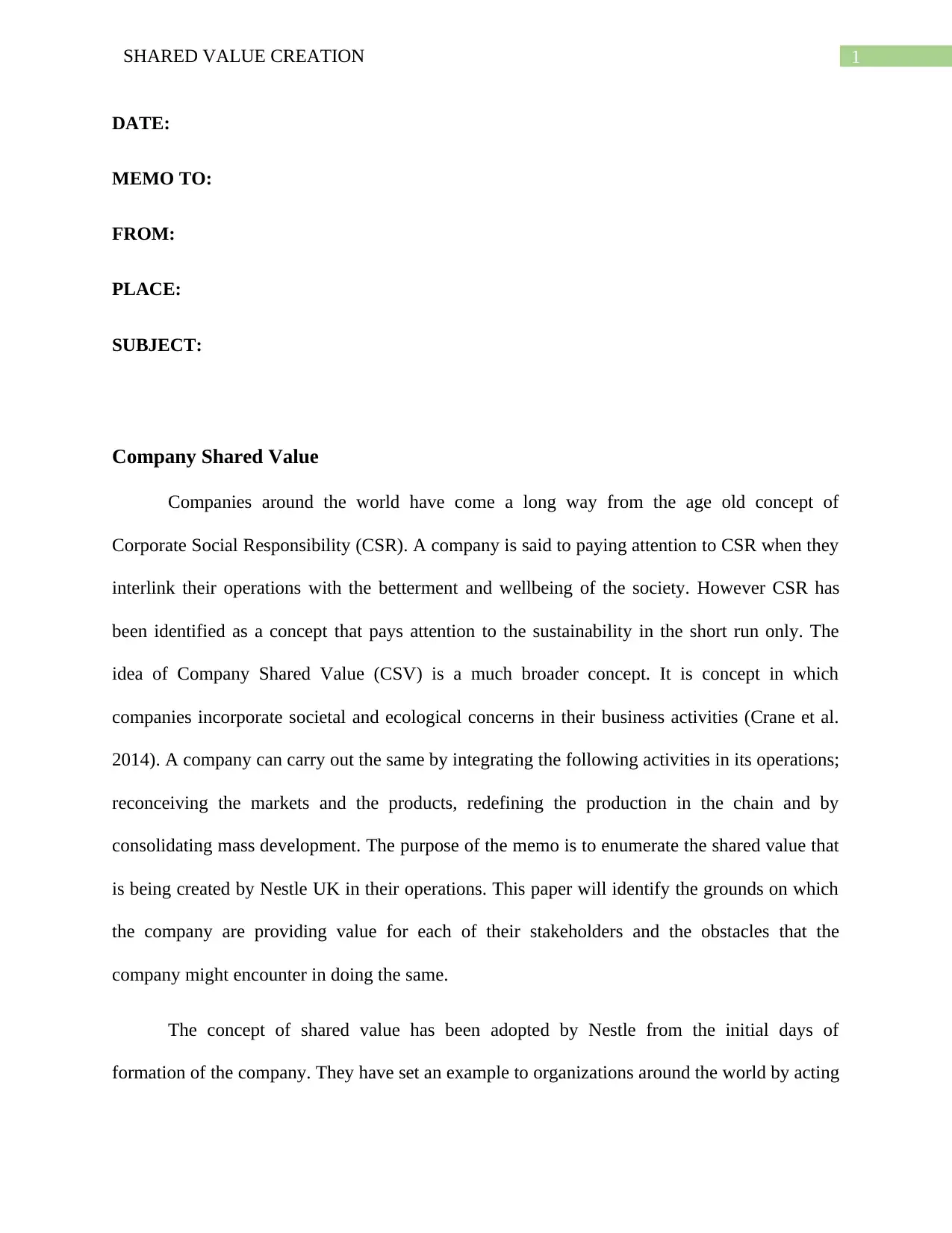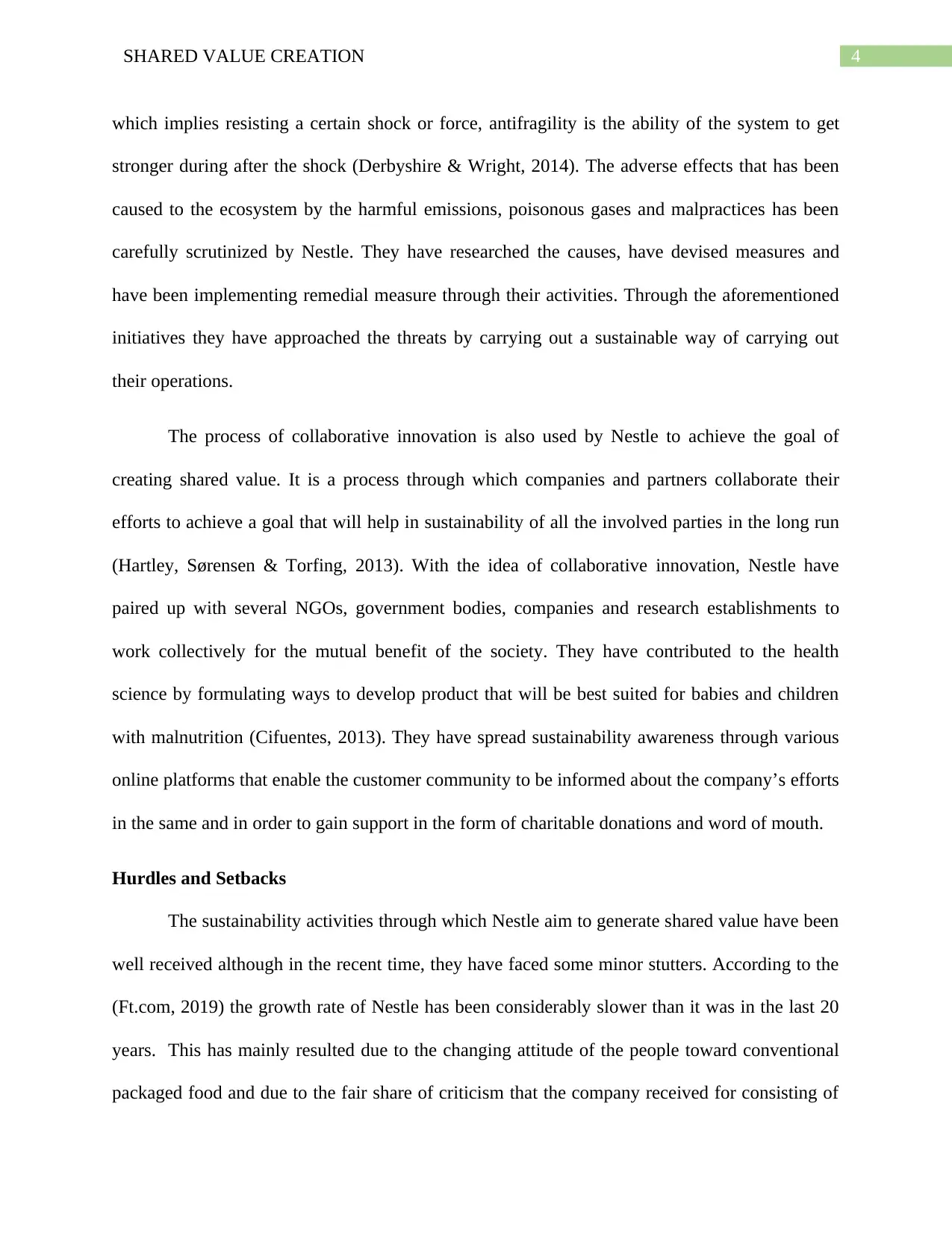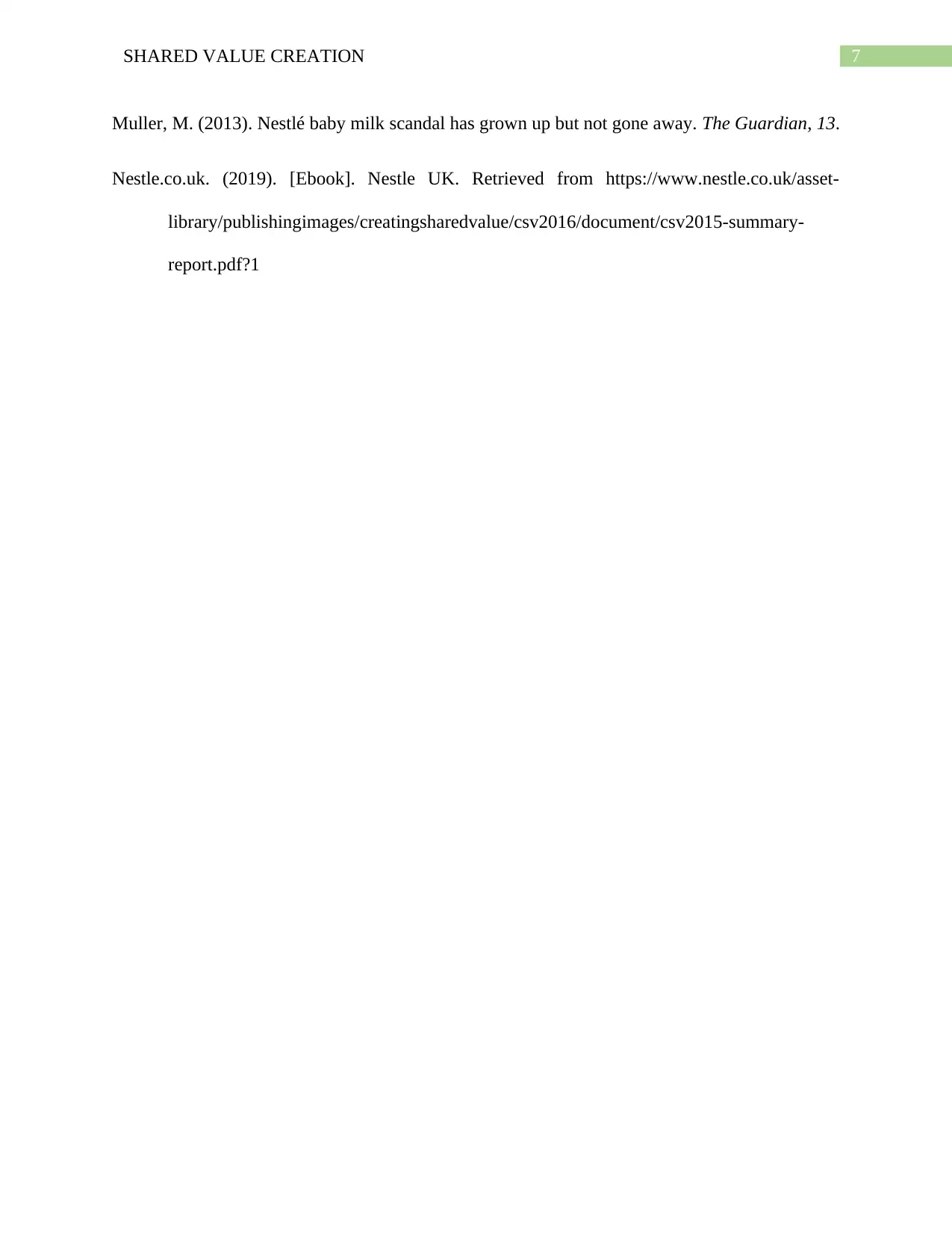Nestle UK's Shared Value Creation: Strategies, Stakeholders & Hurdles
VerifiedAdded on 2023/04/25
|8
|1866
|436
Report
AI Summary
This report examines Nestle UK's approach to creating shared value by integrating societal and ecological concerns into its business operations. It highlights Nestle's commitment to addressing social issues through nutrition, water conservation, and environmental sustainability, showcasing initiatives like reducing water consumption and carbon emissions. The company values its supply chain and stakeholders, including employees, customers, and NGOs, by providing support and promoting sustainable agriculture. Nestle employs systems thinking, antifragility, and collaborative innovation to achieve its goals, partnering with various organizations for mutual benefit. While Nestle has faced challenges, such as slower growth and criticism regarding its product offerings, its long-term goals are aligned with sustainability, positioning the company for future profitability through its contributions to mankind and the environment. Desklib offers a platform for students to access similar solved assignments and past papers.

Running head: SHARED VALUE CREATION
Shared Value Creation
Name of the Student
Name of the University
Author Notes:
Shared Value Creation
Name of the Student
Name of the University
Author Notes:
Paraphrase This Document
Need a fresh take? Get an instant paraphrase of this document with our AI Paraphraser

1SHARED VALUE CREATION
DATE:
MEMO TO:
FROM:
PLACE:
SUBJECT:
Company Shared Value
Companies around the world have come a long way from the age old concept of
Corporate Social Responsibility (CSR). A company is said to paying attention to CSR when they
interlink their operations with the betterment and wellbeing of the society. However CSR has
been identified as a concept that pays attention to the sustainability in the short run only. The
idea of Company Shared Value (CSV) is a much broader concept. It is concept in which
companies incorporate societal and ecological concerns in their business activities (Crane et al.
2014). A company can carry out the same by integrating the following activities in its operations;
reconceiving the markets and the products, redefining the production in the chain and by
consolidating mass development. The purpose of the memo is to enumerate the shared value that
is being created by Nestle UK in their operations. This paper will identify the grounds on which
the company are providing value for each of their stakeholders and the obstacles that the
company might encounter in doing the same.
The concept of shared value has been adopted by Nestle from the initial days of
formation of the company. They have set an example to organizations around the world by acting
DATE:
MEMO TO:
FROM:
PLACE:
SUBJECT:
Company Shared Value
Companies around the world have come a long way from the age old concept of
Corporate Social Responsibility (CSR). A company is said to paying attention to CSR when they
interlink their operations with the betterment and wellbeing of the society. However CSR has
been identified as a concept that pays attention to the sustainability in the short run only. The
idea of Company Shared Value (CSV) is a much broader concept. It is concept in which
companies incorporate societal and ecological concerns in their business activities (Crane et al.
2014). A company can carry out the same by integrating the following activities in its operations;
reconceiving the markets and the products, redefining the production in the chain and by
consolidating mass development. The purpose of the memo is to enumerate the shared value that
is being created by Nestle UK in their operations. This paper will identify the grounds on which
the company are providing value for each of their stakeholders and the obstacles that the
company might encounter in doing the same.
The concept of shared value has been adopted by Nestle from the initial days of
formation of the company. They have set an example to organizations around the world by acting

2SHARED VALUE CREATION
as innovators of the shared value concept. They are constantly showing strides in shared value
creation by working towards mitigating social issues, by operationalizing shared value and by
ensuring their full commitment towards the creation of shared value.
Attention to social issues
Nutrition: Nestle provide products that offer health benefits to the customers. Furthermore the
products that are being provided by nestle are supplied in cheap rates. The company has found
competitive advantage through constant innovation and partnerships.
Conservation of water: Nestle have been advocates for conservation of scare water resources.
They use water efficiently enough so that other members of the supply chain are benefited by the
same. In the year of 2017 Nestle planned to conserve water in their supply chains of milk and by
the year 2020 they aim to reduce the water consumption by 50% with 2010 as a starting point
(Nestle.co.uk. 2019).
Environmental sustainable development: Nestle have identified the need for change that is
required in their plant as a result of the adverse climatic changes. Excluding the hazardous
wastes, no other waste from factories of the company are transferred to incinerators and landfills.
In addition, they have also implemented activities toward low carbon emission and the use of
renewable sources of energy. Most of the packaging materials associated to the products
produced by Nestle are recyclable. By the year 2020, the company aims to reduce emissions of
gas by 40% (Nestle.co.uk. 2019).
Initiative of Rural Development: The Company values the supply chain and the farms from
where they receive their raw materials. Nestle provides support to the development or farmers by
as innovators of the shared value concept. They are constantly showing strides in shared value
creation by working towards mitigating social issues, by operationalizing shared value and by
ensuring their full commitment towards the creation of shared value.
Attention to social issues
Nutrition: Nestle provide products that offer health benefits to the customers. Furthermore the
products that are being provided by nestle are supplied in cheap rates. The company has found
competitive advantage through constant innovation and partnerships.
Conservation of water: Nestle have been advocates for conservation of scare water resources.
They use water efficiently enough so that other members of the supply chain are benefited by the
same. In the year of 2017 Nestle planned to conserve water in their supply chains of milk and by
the year 2020 they aim to reduce the water consumption by 50% with 2010 as a starting point
(Nestle.co.uk. 2019).
Environmental sustainable development: Nestle have identified the need for change that is
required in their plant as a result of the adverse climatic changes. Excluding the hazardous
wastes, no other waste from factories of the company are transferred to incinerators and landfills.
In addition, they have also implemented activities toward low carbon emission and the use of
renewable sources of energy. Most of the packaging materials associated to the products
produced by Nestle are recyclable. By the year 2020, the company aims to reduce emissions of
gas by 40% (Nestle.co.uk. 2019).
Initiative of Rural Development: The Company values the supply chain and the farms from
where they receive their raw materials. Nestle provides support to the development or farmers by
⊘ This is a preview!⊘
Do you want full access?
Subscribe today to unlock all pages.

Trusted by 1+ million students worldwide

3SHARED VALUE CREATION
providing continuous supply of quality materials for production. Nestle will follow the
Sustainable Agriculture network principles in all their future activities while sourcing coffee.
Nestle identify their stakeholders as basically everyone whom they come into contact as
stakeholders. The employees of the company, the customer community, the members of the
supply chain, the NGOs, shareholders and every other associates of the company are identified as
stakeholders. The initiative of shared value that has been undertaken by the company through
their policies offer value to the stakeholders. Not only does nestle provides support to the
communities by looking at sustainable issues, they provide employment and support to the
people of the community. Unlike various companies who look at profitability in the short run,
Nestle does the same in the long run perspective (Da, Liu & Schaumburg, 2013). According to
the Company, profit for them is not limited to monetary profits, it involves gain of the
community as a whole which includes the stakeholders. Not only are the products offered by the
company are being able meet the daily needs of the customers, they are also catering to the needs
of the stakeholders and the same improves the state of their long term profitability and corporate
governance.
The policy makers at Nestle involve a great deal of systems thinking through their
activities. In systems thinking the policy makers zoom out from the generalized causal effect
relationships. They tend to use the zoom out approach to look at the bigger picture (Luhmann,
Baecker & Gilgen, 2013). It is practiced in order to scan how all the components of the world
together are interlinked and responsible for one another. All the sustainability activities that are
carried out by nestle work together to contribute to the benefits of humanity and the prosperity of
the company in the long run (Miah, 2015). Through its activities Nestle have become antifragile.
One should not mix up resiliency with antifragility, they are different concepts. Unlike resilience
providing continuous supply of quality materials for production. Nestle will follow the
Sustainable Agriculture network principles in all their future activities while sourcing coffee.
Nestle identify their stakeholders as basically everyone whom they come into contact as
stakeholders. The employees of the company, the customer community, the members of the
supply chain, the NGOs, shareholders and every other associates of the company are identified as
stakeholders. The initiative of shared value that has been undertaken by the company through
their policies offer value to the stakeholders. Not only does nestle provides support to the
communities by looking at sustainable issues, they provide employment and support to the
people of the community. Unlike various companies who look at profitability in the short run,
Nestle does the same in the long run perspective (Da, Liu & Schaumburg, 2013). According to
the Company, profit for them is not limited to monetary profits, it involves gain of the
community as a whole which includes the stakeholders. Not only are the products offered by the
company are being able meet the daily needs of the customers, they are also catering to the needs
of the stakeholders and the same improves the state of their long term profitability and corporate
governance.
The policy makers at Nestle involve a great deal of systems thinking through their
activities. In systems thinking the policy makers zoom out from the generalized causal effect
relationships. They tend to use the zoom out approach to look at the bigger picture (Luhmann,
Baecker & Gilgen, 2013). It is practiced in order to scan how all the components of the world
together are interlinked and responsible for one another. All the sustainability activities that are
carried out by nestle work together to contribute to the benefits of humanity and the prosperity of
the company in the long run (Miah, 2015). Through its activities Nestle have become antifragile.
One should not mix up resiliency with antifragility, they are different concepts. Unlike resilience
Paraphrase This Document
Need a fresh take? Get an instant paraphrase of this document with our AI Paraphraser

4SHARED VALUE CREATION
which implies resisting a certain shock or force, antifragility is the ability of the system to get
stronger during after the shock (Derbyshire & Wright, 2014). The adverse effects that has been
caused to the ecosystem by the harmful emissions, poisonous gases and malpractices has been
carefully scrutinized by Nestle. They have researched the causes, have devised measures and
have been implementing remedial measure through their activities. Through the aforementioned
initiatives they have approached the threats by carrying out a sustainable way of carrying out
their operations.
The process of collaborative innovation is also used by Nestle to achieve the goal of
creating shared value. It is a process through which companies and partners collaborate their
efforts to achieve a goal that will help in sustainability of all the involved parties in the long run
(Hartley, Sørensen & Torfing, 2013). With the idea of collaborative innovation, Nestle have
paired up with several NGOs, government bodies, companies and research establishments to
work collectively for the mutual benefit of the society. They have contributed to the health
science by formulating ways to develop product that will be best suited for babies and children
with malnutrition (Cifuentes, 2013). They have spread sustainability awareness through various
online platforms that enable the customer community to be informed about the company’s efforts
in the same and in order to gain support in the form of charitable donations and word of mouth.
Hurdles and Setbacks
The sustainability activities through which Nestle aim to generate shared value have been
well received although in the recent time, they have faced some minor stutters. According to the
(Ft.com, 2019) the growth rate of Nestle has been considerably slower than it was in the last 20
years. This has mainly resulted due to the changing attitude of the people toward conventional
packaged food and due to the fair share of criticism that the company received for consisting of
which implies resisting a certain shock or force, antifragility is the ability of the system to get
stronger during after the shock (Derbyshire & Wright, 2014). The adverse effects that has been
caused to the ecosystem by the harmful emissions, poisonous gases and malpractices has been
carefully scrutinized by Nestle. They have researched the causes, have devised measures and
have been implementing remedial measure through their activities. Through the aforementioned
initiatives they have approached the threats by carrying out a sustainable way of carrying out
their operations.
The process of collaborative innovation is also used by Nestle to achieve the goal of
creating shared value. It is a process through which companies and partners collaborate their
efforts to achieve a goal that will help in sustainability of all the involved parties in the long run
(Hartley, Sørensen & Torfing, 2013). With the idea of collaborative innovation, Nestle have
paired up with several NGOs, government bodies, companies and research establishments to
work collectively for the mutual benefit of the society. They have contributed to the health
science by formulating ways to develop product that will be best suited for babies and children
with malnutrition (Cifuentes, 2013). They have spread sustainability awareness through various
online platforms that enable the customer community to be informed about the company’s efforts
in the same and in order to gain support in the form of charitable donations and word of mouth.
Hurdles and Setbacks
The sustainability activities through which Nestle aim to generate shared value have been
well received although in the recent time, they have faced some minor stutters. According to the
(Ft.com, 2019) the growth rate of Nestle has been considerably slower than it was in the last 20
years. This has mainly resulted due to the changing attitude of the people toward conventional
packaged food and due to the fair share of criticism that the company received for consisting of

5SHARED VALUE CREATION
too many brands. The allegations of the activists mainly focuses on the company’s inability to
adapt to the changing consumer tastes and preferences. Nestle have been recognized as the
largest supplier of baby food in the world. Activists who promote the importance of breast
feeding oppose the company’s approach of marketing substitutes to the same (Muller, 2013).
Nestle have been boycott by many such activists and many such organizations globally and are
deemed to be the setbacks in the company’s growth.
Nestle have made noticeable strides in developing in generalizing the idea of company
shared value. The company’s long term goals are properly collaborated with the sustainability
activities that they perform. They have taken into consideration, ideas such as systems thinking,
antifragility and collaborative innovation. All these activities are aimed towards creation of
shared value by catering to sustainable development issues. They have faced a fair share of
criticism and hurdles in the past and present. However it can be concluded that through their
efforts which contribute towards the betterment of mankind Nestle have identified the perfect
strategy to grow sources of their future profitability.
too many brands. The allegations of the activists mainly focuses on the company’s inability to
adapt to the changing consumer tastes and preferences. Nestle have been recognized as the
largest supplier of baby food in the world. Activists who promote the importance of breast
feeding oppose the company’s approach of marketing substitutes to the same (Muller, 2013).
Nestle have been boycott by many such activists and many such organizations globally and are
deemed to be the setbacks in the company’s growth.
Nestle have made noticeable strides in developing in generalizing the idea of company
shared value. The company’s long term goals are properly collaborated with the sustainability
activities that they perform. They have taken into consideration, ideas such as systems thinking,
antifragility and collaborative innovation. All these activities are aimed towards creation of
shared value by catering to sustainable development issues. They have faced a fair share of
criticism and hurdles in the past and present. However it can be concluded that through their
efforts which contribute towards the betterment of mankind Nestle have identified the perfect
strategy to grow sources of their future profitability.
⊘ This is a preview!⊘
Do you want full access?
Subscribe today to unlock all pages.

Trusted by 1+ million students worldwide

6SHARED VALUE CREATION
REFERENCES
Cifuentes, A. (Ed.). (2013). Foodomics: Advanced mass spectrometry in modern food science
and nutrition (Vol. 52). John Wiley & Sons.
Crane, A., Palazzo, G., Spence, L. J., & Matten, D. (2014). Contesting the value of “creating
shared value”. California management review, 56(2), 130-153.
Da, Z., Liu, Q., & Schaumburg, E. (2013). A closer look at the short-term return
reversal. Management science, 60(3), 658-674.
Derbyshire, J., & Wright, G. (2014). Preparing for the future: development of an
‘antifragile’methodology that complements scenario planning by omitting
causation. Technological Forecasting and Social Change, 82, 215-225.
Ft.com (2019). Nestlé sales grow at slowest rate in more than 20 years | Financial Times.
[online] Ft.com. Available at: https://www.ft.com/content/aea17502-1223-11e8-940e-
08320fc2a277 [Accessed 31 Jan. 2019].
Hartley, J., Sørensen, E., & Torfing, J. (2013). Collaborative innovation: A viable alternative to
market competition and organizational entrepreneurship. Public Administration
Review, 73(6), 821-830.
Luhmann, N., Baecker, D., & Gilgen, P. (2013). Introduction to systems theory. Cambridge:
Polity.
Miah, J. H., Griffiths, A., McNeill, R., Poonaji, I., Martin, R., Morse, S., ... & Sadhukhan, J.
(2015). Creating an environmentally sustainable food factory: A case study of the
Lighthouse project at Nestlé. Procedia Cirp, 26, 229-234.
REFERENCES
Cifuentes, A. (Ed.). (2013). Foodomics: Advanced mass spectrometry in modern food science
and nutrition (Vol. 52). John Wiley & Sons.
Crane, A., Palazzo, G., Spence, L. J., & Matten, D. (2014). Contesting the value of “creating
shared value”. California management review, 56(2), 130-153.
Da, Z., Liu, Q., & Schaumburg, E. (2013). A closer look at the short-term return
reversal. Management science, 60(3), 658-674.
Derbyshire, J., & Wright, G. (2014). Preparing for the future: development of an
‘antifragile’methodology that complements scenario planning by omitting
causation. Technological Forecasting and Social Change, 82, 215-225.
Ft.com (2019). Nestlé sales grow at slowest rate in more than 20 years | Financial Times.
[online] Ft.com. Available at: https://www.ft.com/content/aea17502-1223-11e8-940e-
08320fc2a277 [Accessed 31 Jan. 2019].
Hartley, J., Sørensen, E., & Torfing, J. (2013). Collaborative innovation: A viable alternative to
market competition and organizational entrepreneurship. Public Administration
Review, 73(6), 821-830.
Luhmann, N., Baecker, D., & Gilgen, P. (2013). Introduction to systems theory. Cambridge:
Polity.
Miah, J. H., Griffiths, A., McNeill, R., Poonaji, I., Martin, R., Morse, S., ... & Sadhukhan, J.
(2015). Creating an environmentally sustainable food factory: A case study of the
Lighthouse project at Nestlé. Procedia Cirp, 26, 229-234.
Paraphrase This Document
Need a fresh take? Get an instant paraphrase of this document with our AI Paraphraser

7SHARED VALUE CREATION
Muller, M. (2013). Nestlé baby milk scandal has grown up but not gone away. The Guardian, 13.
Nestle.co.uk. (2019). [Ebook]. Nestle UK. Retrieved from https://www.nestle.co.uk/asset-
library/publishingimages/creatingsharedvalue/csv2016/document/csv2015-summary-
report.pdf?1
Muller, M. (2013). Nestlé baby milk scandal has grown up but not gone away. The Guardian, 13.
Nestle.co.uk. (2019). [Ebook]. Nestle UK. Retrieved from https://www.nestle.co.uk/asset-
library/publishingimages/creatingsharedvalue/csv2016/document/csv2015-summary-
report.pdf?1
1 out of 8
Related Documents
Your All-in-One AI-Powered Toolkit for Academic Success.
+13062052269
info@desklib.com
Available 24*7 on WhatsApp / Email
![[object Object]](/_next/static/media/star-bottom.7253800d.svg)
Unlock your academic potential
Copyright © 2020–2025 A2Z Services. All Rights Reserved. Developed and managed by ZUCOL.





